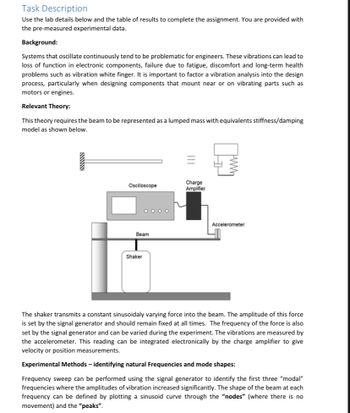
Structural Analysis
6th Edition
ISBN: 9781337630931
Author: KASSIMALI, Aslam.
Publisher: Cengage,
expand_more
expand_more
format_list_bulleted
Concept explainers
Question
thumb_up100%
Only do B
![Pre-measured experimental data:
Using the experimental data given below, complete the lab report as detailed in the deliverable.
Beam dimensions - breadth=0.0254m, depth=0.0032m, length=0.410m.
Damped natural frequency
U11
@d2
@d3
wn = az
Experimentally measured
value (Hz)
12.02
90.84
214.7
Deliverable
(a) Mathematical modelling of the cantilever beam: Theoretically model the cantilever beam,
using the physical measurements of the cantilever beam, as one degree of freedom system.
Calculate the first natural frequency of the beam.
EI
PALA
(b) Research Euler-Bernoulli beam theory and utilising the physical measurements of the
cantilever beam. Calculate the first three natural frequencies of your experimental system
using Euler Bernoulli beam theory.
Theoretical details:
The fixed-free cantilever beam system is an example of a continuous distribution of mass system
and can have many natural frequencies. Euler Bernoulli beam theory yields a formula [1] to
calculate the natural frequencies of your experimental system.
Node, distance from fixed end
of the beam (m)
E-Young's modulus for mild steel = 210GPa
L-Length of the beam
A- the cross-sectional area of the beam
p - the density for the beam, for mild steel = 7850Kgm-³
an - is a constant, for a fixed-free beam
Where I is the second moment of area [2]
1=bd²
b-breadth of the beam
d-depth of the beam
0.335
0.187, 0.350
[1]
a₁ = 1.875 a₂ = 4.694 a3 = 7.855
[2]](https://content.bartleby.com/qna-images/question/3439725b-3e6e-42dc-b1ea-4b06aba6a92e/31ceba12-fd15-4991-b5be-6dbbf34c9bb6/kaopfog_thumbnail.jpeg)
Transcribed Image Text:Pre-measured experimental data:
Using the experimental data given below, complete the lab report as detailed in the deliverable.
Beam dimensions - breadth=0.0254m, depth=0.0032m, length=0.410m.
Damped natural frequency
U11
@d2
@d3
wn = az
Experimentally measured
value (Hz)
12.02
90.84
214.7
Deliverable
(a) Mathematical modelling of the cantilever beam: Theoretically model the cantilever beam,
using the physical measurements of the cantilever beam, as one degree of freedom system.
Calculate the first natural frequency of the beam.
EI
PALA
(b) Research Euler-Bernoulli beam theory and utilising the physical measurements of the
cantilever beam. Calculate the first three natural frequencies of your experimental system
using Euler Bernoulli beam theory.
Theoretical details:
The fixed-free cantilever beam system is an example of a continuous distribution of mass system
and can have many natural frequencies. Euler Bernoulli beam theory yields a formula [1] to
calculate the natural frequencies of your experimental system.
Node, distance from fixed end
of the beam (m)
E-Young's modulus for mild steel = 210GPa
L-Length of the beam
A- the cross-sectional area of the beam
p - the density for the beam, for mild steel = 7850Kgm-³
an - is a constant, for a fixed-free beam
Where I is the second moment of area [2]
1=bd²
b-breadth of the beam
d-depth of the beam
0.335
0.187, 0.350
[1]
a₁ = 1.875 a₂ = 4.694 a3 = 7.855
[2]

Transcribed Image Text:Task Description
Use the lab details below and the table of results to complete the assignment. You are provided with
the pre-measured experimental data.
Background:
Systems that oscillate continuously tend to be problematic for engineers. These vibrations can lead to
loss of function in electronic components, failure due to fatigue, discomfort and long-term health
problems such as vibration white finger. It is important to factor a vibration analysis into the design
process, particularly when designing components that mount near or on vibrating parts such as
motors or engines.
Relevant Theory:
This theory requires the beam to be represented as a lumped mass with equivalents stiffness/damping
model as shown below.
Oscilloscope
Beam
Shaker
Charge
Amplifier
Accelerometer
The shaker transmits a constant sinusoidaly varying force into the beam. The amplitude of this force
is set by the signal generator and should remain fixed at all times. The frequency of the force is also
set by the signal generator and can be varied during the experiment. The vibrations are measured by
the accelerometer. This reading can be integrated electronically by the charge amplifier to give
velocity or position measurements.
Experimental Methods - identifying natural Frequencies and mode shapes:
Frequency sweep can be performed using the signal generator to identify the first three "modal"
frequencies where the amplitudes of vibration increased significantly. The shape of the beam at each
frequency can be defined by plotting a sinusoid curve through the "nodes" (where there is no
movement) and the "peaks".
Expert Solution
This question has been solved!
Explore an expertly crafted, step-by-step solution for a thorough understanding of key concepts.
Step by stepSolved in 3 steps

Knowledge Booster
Learn more about
Need a deep-dive on the concept behind this application? Look no further. Learn more about this topic, civil-engineering and related others by exploring similar questions and additional content below.Similar questions
- Determine the value of dimension d so that the resultant of the two couple is 350 N.m clockwisearrow_forwardsolvearrow_forward(8.) Draw the following network: a. G follows F but precede H b. G follows D but precede J c. M follows H but precede L d. K follows A but precede L e. F follows A f. A and D start at the same time g. J and L terminate at the same time.arrow_forward
arrow_back_ios
arrow_forward_ios
Recommended textbooks for you

 Structural Analysis (10th Edition)Civil EngineeringISBN:9780134610672Author:Russell C. HibbelerPublisher:PEARSON
Structural Analysis (10th Edition)Civil EngineeringISBN:9780134610672Author:Russell C. HibbelerPublisher:PEARSON Principles of Foundation Engineering (MindTap Cou...Civil EngineeringISBN:9781337705028Author:Braja M. Das, Nagaratnam SivakuganPublisher:Cengage Learning
Principles of Foundation Engineering (MindTap Cou...Civil EngineeringISBN:9781337705028Author:Braja M. Das, Nagaratnam SivakuganPublisher:Cengage Learning Fundamentals of Structural AnalysisCivil EngineeringISBN:9780073398006Author:Kenneth M. Leet Emeritus, Chia-Ming Uang, Joel LanningPublisher:McGraw-Hill Education
Fundamentals of Structural AnalysisCivil EngineeringISBN:9780073398006Author:Kenneth M. Leet Emeritus, Chia-Ming Uang, Joel LanningPublisher:McGraw-Hill Education
 Traffic and Highway EngineeringCivil EngineeringISBN:9781305156241Author:Garber, Nicholas J.Publisher:Cengage Learning
Traffic and Highway EngineeringCivil EngineeringISBN:9781305156241Author:Garber, Nicholas J.Publisher:Cengage Learning


Structural Analysis (10th Edition)
Civil Engineering
ISBN:9780134610672
Author:Russell C. Hibbeler
Publisher:PEARSON

Principles of Foundation Engineering (MindTap Cou...
Civil Engineering
ISBN:9781337705028
Author:Braja M. Das, Nagaratnam Sivakugan
Publisher:Cengage Learning

Fundamentals of Structural Analysis
Civil Engineering
ISBN:9780073398006
Author:Kenneth M. Leet Emeritus, Chia-Ming Uang, Joel Lanning
Publisher:McGraw-Hill Education


Traffic and Highway Engineering
Civil Engineering
ISBN:9781305156241
Author:Garber, Nicholas J.
Publisher:Cengage Learning